I took this camera with on the same road trip as the Techni-Pak 1. So it's more of the same slightly ugly, yet very interesting ghost/mining town stuff. First off, I have to say I think this is probably my first roll of color 35mm in at least 10 years. Maybe even a bit longer. So, while I don't hate it or anything, it just hasn't been my thing. So it was a bit interesting to me to see what I would come up with. I just have a hard time seeing beyond the "they look like snapshots of cool things" vibe. I tried my best, though. I scanned from the negatives, not the prints that came with them.
We start with full daylight. This is 1600 speed film that is supposed to look 'natural' in daylight and low light without a flash. This shot is probably around noon with full sun.
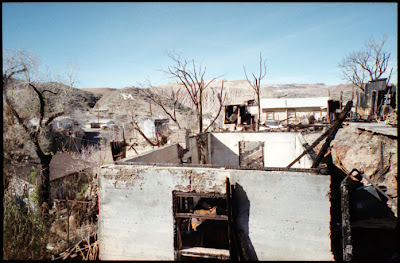
Nice, sharp image. As with the black and white film, it seems to be on the edge of overexposure. But maybe that's just because I'm used to Kodak 400 and cheaper 35mm cameras. These next two shots were taken in a very dark abandoned building. If I had used one of my toy cameras, I might have gotten a couple strips of light, but no image. This is what the camera is designed to do, without a flash, and it works quite well.
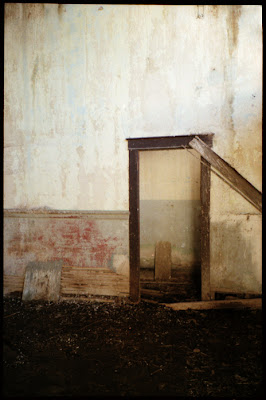
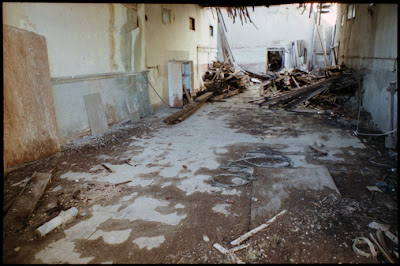
I know the shots aren't that impressive, but it really is amazing that these are just 'point at and shoot' photos in a very dark room, with no flash. I mean, seriously, the camera adjusts better to the shade than my eyes do. The detail is incredible, and the colors are as accurate as I imagine they would be, considering that I couldn't see the colors all that well. This is the outside of that same building. The dark area below is where the two above photos were shot. You can see that the camera does what it is supposed to do - adjust exposure depending on the light source. I think I'm repeating myself.
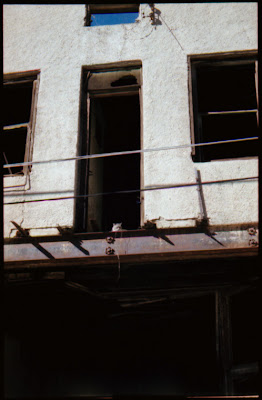
Moving on, another shot inside of a dark kitchen of an abandoned house.
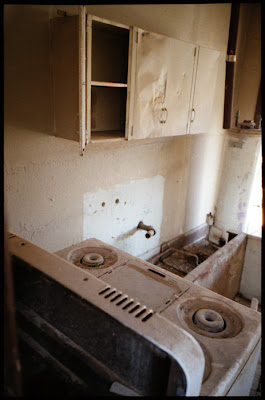
Again, nice job working in low light. Colors seem to be fairly accurate. If that kitchen could be considered to have 'color'. The same building shot from the outside shows the camera to falter a bit in its abilities.
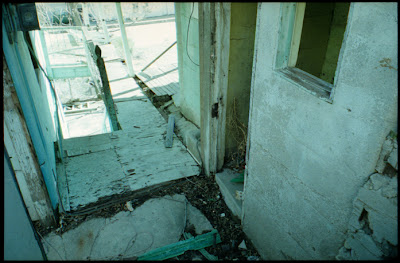
The camera exposed for the shaded area in the foreground, leaving the sunny area blown out. This is pretty common for auto-exposure cameras. Still, the camera handles it fairly well...certainly better than my digital, which often leaves areas completely black or fully blown out depending on what it exposes for.
Later, as the sun began to set, I took a few low light dusk shots. If it can shoot a dark room, it shouldn't have a problem shooting in low light outside. For comparison, a shot with my Polaroid 195 and very expired 665 (1985 to be exact...I think I got four shots out of the pack that weren't dried up).
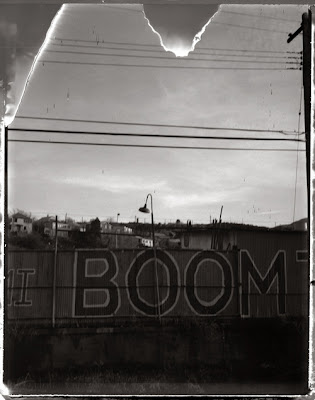
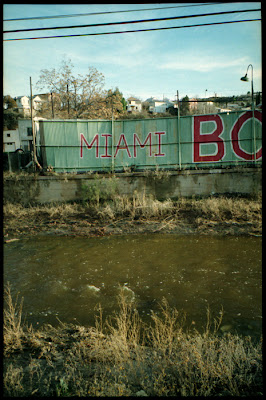
One thing about it...it's actually kind of difficult to tell what time your shots were taken, because it still looks like full daylight. I think this was about an hour before dark, and the sun was starting to hide behind the mountains. You also get a good idea of how much wider the Fuji camera shoots. I wasn't aiming at the exact same spot, but I was standing in the same place for both shots.
About a half an hour later, it's pretty dusky. For comparison, the same wall shot with the Fuji and with a Stellar (Diana clone).
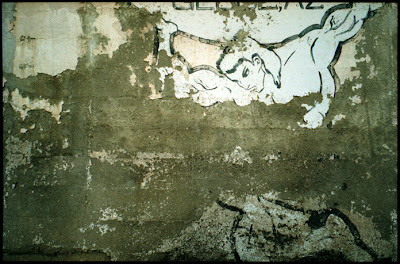
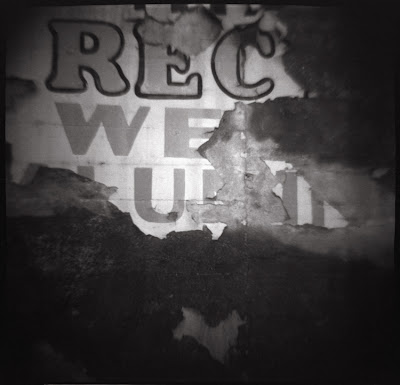
The Stellar actually did fairly well, but the Classica didn't even break a sweat. I also took a couple shots of the kitties inside again, but they weren't even worth scanning. The shots without the flash were blurry and grainy...which looks much better in black and white than in color. In color, it just looks muddy and ugly. The flash shot looked like a color shot taken with a flash (central bright, background black).
So that's it for the Fuji Natura Classica review! Again, great little camera. The shutter does slow down in very low light, so things will blur, but I didn't get any blur from camera shake with static objects. I prefer black and white over color, but it works well with both. An all-around nifty little point and shoot camera.
Still planning on a big Polaroid 150/Type 47 post here in the next few weeks. School has started, so life is a bit of a drag once again. Adios!

"more of the same slightly ugly, yet very interesting ghost/mining town stuff" - we have run down old mining towns but nothing as fantastic as this!
ReplyDeleteKeep the posts coming. Hope you don't mind but I've lined you in mt blogroll.
J
After reading your review I picked up a classica on ebay and I'm running my first roll through it... however I've got a question. When using 1600 film the camera automatically shots in NP mode, right? So it is basically meant for available light photography.
ReplyDeleteHowever, when shooting indoors and dark scenes, if I press the shutter button halfway a red light flashes (the one on top of the green focus light), and I assume it is a "warning" sign meaning the camera actually advises to turn on the flash... am I correct?
Yes, it seems to have its limits. You can even see the flash symbol on the window will flash without the "cross out". BUT, if the camera is steady, it will still do its best to expose properly, as in the photo taken through the window of the dark building with the dump truck in it. It just keeps the shutter open longer. I guess it just depends on what and how you are shooting. Moving objects, etc. I've noticed that it sometimes just requires aiming at a lighter colored object in the darker area. The meter seems to be dead center of the viewfinder.
ReplyDeleteI haven't really noticed a difference when setting the camera at night exposure. It still flashes red or green in the same places.
The AF light always flashes green, no matter how dark it is. You can put your hand up the the lens and the AF light is still green, so I don't quite get the point of it.
Since the Natura Classica compresses the light, does this mean you don't have problems with blurring in low light areas or do some situations require a tripod?
ReplyDeleteit all depends on how low the light source is. a tripod can never hurt, of course, but i didn't have any issues with photographing static subjects and holding the camera. camera shake has never been a problem so far...only when the subjects are moving.
ReplyDeleteMaimi Oklahoma? is that correct? where do you get the fuji Natura classica in the USA?
ReplyDeletemiami, arizona. i got it online, import from japan. i see lomography sells them now, though, for not much more than i pain, i think.
ReplyDeleteDid you make actual prints? If so, how much grain is there? I haven't shot 1600ISO in quite a long time, but I remember it being quite grainy. I don't really see any grain in your pictures in the post, but I don't know if that's because of the low resolution of a computer screen or because there isn't any there. It's hard for me to believe that there's no grain in a 1600ISO picture!
ReplyDeletelove the first interior of the abandoned building. thanks for posting these.
ReplyDeleteFantastic shots. I never knew this camera existed, I'm very curious!
ReplyDeletejust discovered this camera. amazing!
ReplyDeleteHi, i just read your great review. I wonder if there is a possibility to set the iso-Value manual if there are no DX-Contacts? This would be nice, as there are a lot of old or "creative" Films round here that would be nice to use in the natura.
ReplyDeleteI'm interested in Natura Classica too. Where did you buy it and where is it made from?
ReplyDeletei got mine from a shop in japan. it is a japanese camera. lomography sells them and the price is actually comparable.
ReplyDeleteI love it so much that I cant wait to get my hand on it
ReplyDeleteUsing the NP mode, I still get the blinking red light when I am focusing on a dim area. Is it alright to snap a picture? Will it turn out alright or do I have to adhere to only a green light before I snap away?
ReplyDeletei've noticed that. i still take the shot...
ReplyDeleteSo the picture will turn out ok? Sorry to be asking so much as I am still learning about this camera. How does the camera recognize if I'm using 800 or 1600 films?
ReplyDeleteif it's not too dark it should be fine.
ReplyDelete35mm canisters have a bar code thing on them that tells the camera what kind of film is in it.
i'm very excited about getting this camera. i think it's going to be my next purchase.
ReplyDeleteHi, can i check where did you buy the natura classica from in Japan? which place can i find it ? I will be going there next wek
ReplyDeletei got mine online, but i saw them in the big camera shops in tokyo. Bic in Shibuya had them.
ReplyDeletePhotography is the art, science and practice of creating durable images by recording light or other electromagnetic radiation, either electronically by means of an image sensor or chemically by means of a light-sensitive material such as photographic film.[1] Typically, a lens is used to focus the light reflected or emitted from objects into a real image on the light-sensitive surface inside a camera during a timed exposure. The result in an electronic image sensor is an electrical charge at each pixel, which is electronically processed and stored in a digital image file for subsequent display or processing. The result in a photographic emulsion is an invisible latent image, which is later chemically developed into a visible image, either negative or positive depending on the purpose of the photographic material and the method of processing. A negative image on film is traditionally used to photographically create a positive image on a paper base, known as a print, either by using an enlarger or by contact printing.
ReplyDeleteThanks for the awesome post :)
ReplyDeleteI own a Natura Classica and wanted to ask, does your viewfinder always seem a little blurry and distorted?
It's not the best viewfinder haha but not sure if my is defective.
Also have you ever flashed an led light through it to see dust etc in it?
Mine seems to have some.
Thanks so much :)